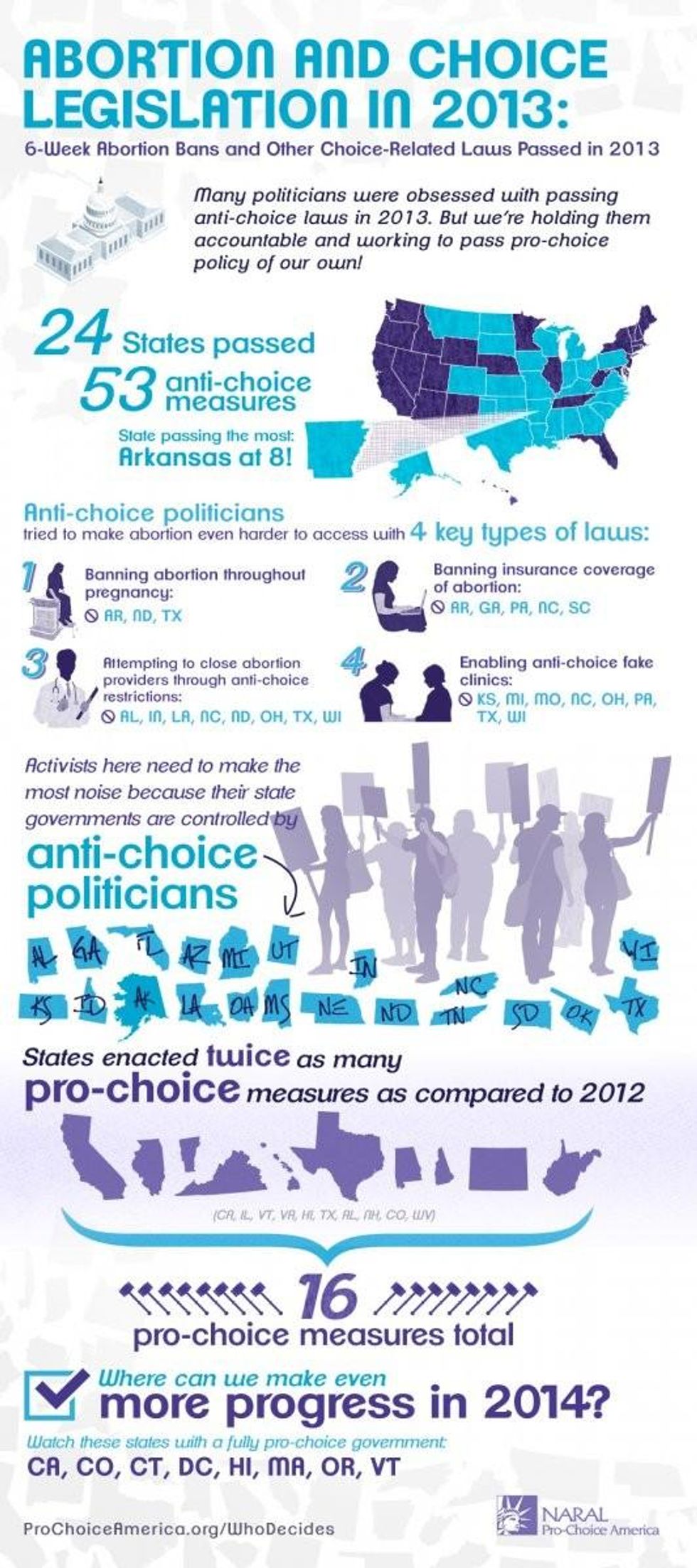The anniversary of Roe v. Wade always brings familiar sights in Washington, D.C., and this Jan. 22, the 41st anniversary of that landmark Supreme Court case, is no different. Anti-choice protesters -- many on a break from the Republican National Committee's winter meeting -- will march through the streets, calling for an end to legal abortion. Organizations like the one I lead, NARAL Pro-Choice America, will celebrate the anniversary of the decision that enshrined into law a woman's freedom to decide when, how and with whom to have a family.
Like these annual rituals, the war over abortion rights can give you a case of deja vu, but as the new president of a reproductive freedom organization, I have a different perspective. Sure, 2013 was not a great year for reproductive freedom -- 53 anti-choice measures were adopted at the state level, and we narrowly averted a federal government shutdown when House Republicans demanded that bosses have control over their employees' birth control coverage (though we later had a shutdown, anyway).
But 2013 also showed record-high public support for the rights enshrined in Roe v. Wade: Twice as many pro-choice measures as the prior year were enacted at the state level, and voters turned out to vote into office a pro-choice governor in Virginia and soundly defeat the first municipal ballot measure to ban abortion after 20 weeks. In 2013, we saw a movement starting to embody the old adage that the best defense is a good offense.
It will take time for this shifting momentum to result in a full sea change. We're in the midst of a decadeslong strategy by anti-choice activists to chip away at reproductive rights. This well-coordinated and well-funded movement has taken over statehouses, paid careful attention to judicial appointments and used redistricting efforts to make sure anti-choice politicians have a solid foothold in the House of Representatives. The impact has been severe and the stakes are high. A study published in 2013 to evaluate the impact of the 2011 clinic closures showed that 7 percent of women who need abortion care in Texas try to self-abort. Americans have been down this road, and we know where it leads.
But 2013 also offered ample evidence that politicians understand just how outside the mainstream they are on these issues. Time after time, we saw elected officials obfuscate and bend the rules to ram through abortion restrictions, as in North Carolina, where Gov. Pat McCrory recanted a campaign promise and signed a litany of restrictions that had been substituted into a "motorcycle safety bill." His favorability rating promptly took a dive. Gov. John Kasich of Ohio passed his restrictions in a budget bill, and Gov. Rick Perry had to call two special sessions to get the Texas abortion restrictions that made Wendy Davis a national star passed by the state Senate.
Old arguments are wearing thin, too. Gone are the days when conservatives could marginalize abortion access as a social issue and claim elections hinge on economic matters, especially with women driving the margin of victory in so many elections. Women in this country know that our economic security depends on our ability to decide when and with whom we have families. More and more middle-class families dependent on two incomes viscerally understand the inextricable connection between access to family planning and their economic outlook. This is no secret: Global data prove that in countries where women have access to family planning, all other socioeconomic indicators outperform countries where women do not.
And yet, elected officials who vote for abortion restrictions disproportionately also vote against contraception access, comprehensive sex education and the kinds of measures that support women who do have families, including paid sick days, maternal leave and funding for day care and early education. Officials who vote this way are not anti-abortion; they are doggedly committed to legislating morality about how women behave in society. This worldview doesn't match most people's experience and is antithetical to the freedom and equality prized by most Americans.
But momentum is shifting. In 2013, we saw the House and Senate introduce the Women's Health Protection Act, which would assure that women have the right to access abortion regardless where they live. And in New York, Gov. Andrew Cuomo received national attention for his integrated agenda to support women's rights in his Women's Equality Act, which combined expanded protections for abortion access with ending gender-based wage, housing and employment discrimination.
These are just the tip of the iceberg. The pro-choice movement has had enough of an extreme minority taking up a disproportionate amount of political space with an ideologically driven and outdated agenda. In 2014, the pendulum starts to swing back.
